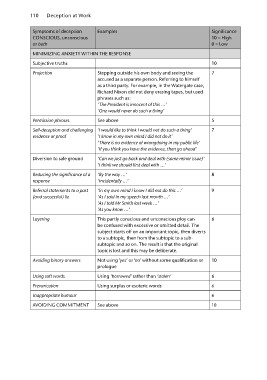Page 69 - Deception at work all chapters EBook
P. 69
110 Deception at Work
Symptoms of deception Examples Significance
CONSCIOUS, unconscious 10 = High
or both 0 = Low
MINIMIZING ANXIETY WITHIN THE RESPONSE
Subjective truths 10
Projection Stepping outside his own body and seeing the 7
accused as a separate person. Referring to himself
as a third party. For example, in the Watergate case,
Richard Nixon did not deny erasing tapes, but used
phrases such as:
‘The President is innocent of this …’
‘One would never do such a thing’
Permission phrases See above 5
Self-deception and challenging ‘I would like to think I would not do such a thing’ 7
evidence or proof ‘I know in my own mind I did not do it’
‘There is no evidence of wrongdoing in my public life’
‘If you think you have the evidence, then go ahead’
Diversion to safe ground ‘Can we just go back and deal with (some minor issue)’
‘I think we should first deal with …’
Reducing the significance of a ‘By the way …’ 8
response ‘Incidentally …’
Referral statements to a past ‘In my own mind I know I did not do this …’ 9
(and successful) lie ‘As I said in my speech last month …’
‘As I told Mr Smith last week …’
‘As you know …’
Layering This partly conscious and unconscious ploy can 6
be confused with excessive or omitted detail. The
subject starts off on an important topic, then diverts
to a subtopic, then from the subtopic to a sub-
subtopic and so on. The result is that the original
topic is lost and this may be deliberate.
Avoiding binary answers Not using ‘yes’ or ‘no’ without some qualification or 10
prologue
Using soft words Using ‘borrowed’ rather than ‘stolen’ 6
Prevarication Using surplus or esoteric words 6
Inappropriate humour 6
AVOIDING COMMITMENT See above 10

